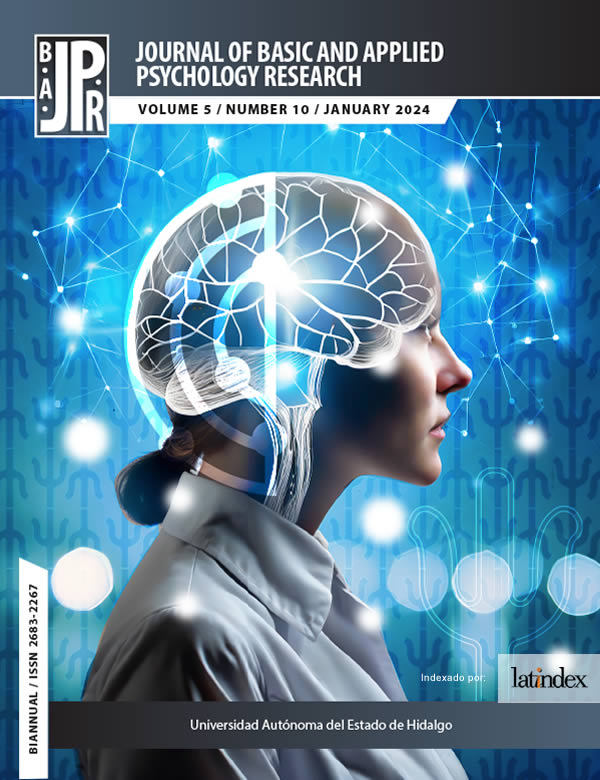Validation of the health belief model scale for generalized anxiety in Mexican adult of general population
DOI:
https://doi.org/10.29057/jbapr.v5i10.12199Keywords:
Generalized anxiety, scale, health belief model, validation, factor analysisAbstract
According to the literature review, there are theoretical models that explain the presence of anxiety in people. These explanations agree that beliefs regarding control and the perception of vulnerability to worry seem to play an important role in the onset and maintenance of generalized anxiety disorder (GAD). Perceiving oneself capable of modifying these concerns facilitates change and taking action in the face of worrying situations in everyday life. The Health Belief Model (HBM) has been one of the most widely used conceptual frameworks to explain the change and maintenance of behaviors related to different health situations and to develop scales that allow identifying beliefs related to the problem in question, however , there are no scales based on this model for generalized anxiety, so the purpose of this research was the construction and validation of a scale with these characteristics. The construction of the items was carried out based on the dimensions that make up the HBM and subsequently validation by judges was carried out. Scales of anxiety, depression, life satisfaction, and self-efficacy were applied to establish the convergent and discriminant validity of the scale. Finally, an Exploratory Factor Analysis was carried out, from which 24 Likert-type scale items were obtained that were grouped into 5 dimensions, explaining 58.6% of the total variance and with a total Cronbach's alpha of .803.
Downloads
Publication Facts
Reviewer profiles N/A
Author statements
Indexed in
- Academic society
- N/A
- Publisher
- Universidad Autónoma del Estado de Hidalgo
References
Barlow, D. H. (2004). Anxiety and its disorders: The nature and treatment of anxiety and panic. Guilford press.
Bekhbat, M., & Neigh, G. N. (2018). Sex differences in the neuro-immune consequences of stress: Focus on depression and anxiety. Brain, behavior, and immunity, 67, 1-12.
Becker, M. H. & Maiman, L. A. (1995). Sociobehavioural determinants of compliance with health and medical care recommendations. Medical Care, 13, 10-24.
Borkovec, T.D. (1994). “The nature, functions, and origins of worry. En G. Davey y F. Tallis (Eds.). Worrying: Perspectives on theory, assessment and treatment, pp. 5-33. Sussex, England: Wiley & Sons.
Díaz, M. V., Medina, M. P. M., Pérez, M. M., & Blázquez, F. P. (2016). Modelos explicativos del trastorno por ansiedad generalizada y de la preocupación patológica. Revista de Psicología GEPU, 7(2), 156-167.
Davey, G.C.L. (2006). A mood-as-input account of perseverative worrying. In Davey G. y Wells A. (Eds.). Worry and Its Psychological Disorders: Theory, Assessment and Treatment. England: Wiley.
Dugas, M. J., Gagnon, F., Ladouceur, R., & Freeston, M. H. (1998). Generalized anxiety disorder: A preliminary test of a conceptual model. Behaviour research and therapy, 36(2), 215-226.
Conner, M., & Norman, P. (2005). Predicting health behaviour. McGraw-Hill Education (UK).
Jerez, C., Lázaro, J. J., & Ullán, A. M. (2016). Evaluación de las escalas empleadas para determinar la ansiedad y el comportamiento del niño durante la inducción de la anestesia. Revisión de la literatura. Revista Española de Anestesiología y Reanimación, 63(2), 101-107.
Koerner, N., McEvoy, P., & Tallon, K. (2020). Cognitive‐Behavioral Models of Generalized Anxiety Disorder (GAD) Toward a Synthesis. Generalized Anxiety Disorder and Worrying: A Comprehens
OECD. (2014). Making mental health count: The social and economic costs of neglecting mental health care.
Organización Mundial de la Salud. (2017). Día Mundial de la Salud Mental 2017 – La salud mental en el lugar de trabajo. Recuperado el 29 de marzo de 2019, de http://www.who.int/mental_health/world-mental-health-day/2017/es/
San Pedro, E. M., & Roales-Nieto, J. G. (2003). El modelo de creencias de salud: revisión teórica, consideración crítica y propuesta alternativa. I: hacia un análisis funcional de las creencias en salud. International Journal of Psychology and Psychological Therapy, 3(1), 91-109. (San Pedro, Roales-Nieto, 2003)

















